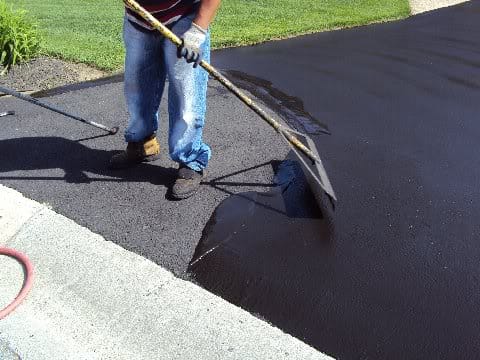Unlock the Secrets of Asphalt Sealing: Making The Most Of Hot Mix Asphalt Durability
Unlock the Secrets of Asphalt Sealing: Making The Most Of Hot Mix Asphalt Durability
Blog Article
Hot Mix Asphalt: A Sustainable Service for Sidewalk
Hot Mix Asphalt (HMA) has actually emerged as a leading lasting selection for pavement solutions, supplying a myriad of innovative technologies and ecological benefits. As the demand for eco-friendly construction techniques expands, checking out the nuances of HMA's sustainability can provide valuable understandings right into the future of pavement remedies.
Ecological Advantages of Warm Mix Asphalt

Furthermore, Hot Mix Asphalt aids to mitigate urban warmth island impacts. Its dark shade absorbs sunshine, minimizing the quantity of warmth reflected back right into the ambience contrasted to lighter-colored sidewalks. This can reduce ambient temperatures in urban locations, reducing the demand for cooling and ultimately reducing power usage.
On top of that, Warm Mix Asphalt adds to improved stormwater management. Its porous nature permits water to infiltrate the sidewalk and charge groundwater supplies, minimizing overflow and the risk of flooding. These ecological advantages make Warm Mix Asphalt a sustainable option for paving freeways and roads.
Power Effectiveness in HMA Manufacturing
Is energy efficiency a vital factor in the manufacturing of Hot Mix Asphalt (HMA)? Power plays a substantial duty in the production of HMA, impacting both expense and environmental sustainability. One essential facet of power efficiency in HMA manufacturing is the use of cozy mix asphalt (WMA) technologies.
Moreover, developments in plant technologies have led to even more energy-efficient HMA production processes. By optimizing energy use in HMA production, the market can reduce its carbon impact while maintaining high-quality pavement materials.
Recyclability of Warm Mix Asphalt
The recyclability of Warm Mix Asphalt (HMA) is a critical facet of its sustainability and lasting ecological influence. HMA is among the most recycled products in the USA, with over 100 million bunches of redeemed asphalt sidewalk (RAP) being recycled every year in new pavement building and construction. Recycling HMA supplies a number of environmental advantages, such as decreasing the requirement for virgin products, decreasing energy usage during manufacturing, and lowering the amount of waste sent to landfills.
The procedure of reusing HMA involves grating the existing pavement, crushing it into smaller pieces, and mixing it with new aggregate and asphalt binder to produce a recycled mix. This recycled mix can typically do along with and even far better than conventional HMA, while calling for fewer raw materials and generating lower greenhouse gas exhausts. By integrating RAP into brand-new sidewalk tasks, road companies can conserve natural deposits, minimize expenses, and decrease the environmental footprint of roadway construction and upkeep activities. Overall, the recyclability of HMA plays a substantial function in advertising sustainable methods within the pavement industry.

Long-Term Performance of HMA
Asphalt sidewalks demonstrate toughness and resilience over an extended duration, mirroring the lasting performance of Warm Mix Asphalt (HMA) The durability of HMA can be attributed to its capacity to hold up against hefty traffic tons, rough climate condition, and the impacts of aging. Studies have actually shown that well-designed and useful site properly built HMA sidewalks can last for 20 years or more with normal maintenance. The secret to taking full advantage of the lasting performance of HMA hinges on using high-quality materials, complying with finest techniques in building, and implementing effective upkeep approaches. Appropriate drain, regular examinations, and timely repairs are important for maintaining the architectural stability weblink of HMA sidewalks with time. Furthermore, improvements in HMA technology, such as making use of polymer-modified binders and cozy mix asphalt, have better boosted the sturdiness and durability of HMA pavements. By prioritizing quality building and upkeep practices, HMA continues to confirm itself as a cost-effective and sustainable solution for resilient pavement framework.

HMA: Toughness and Sustainability
Showing both toughness and sustainability, Hot Mix Asphalt (HMA) has ended up being a foundation in the construction of durable pavement frameworks - commercial parking lot paving. HMA's toughness comes from his response its capability to endure heavy loads, harsh climate conditions, and high website traffic volumes, making it a dependable option for roads, highways, and flight terminal runways. The composition of HMA, which typically includes aggregates, binder, and filler, plays a critical duty in improving its longevity and resistance to tear and put on
Moreover, HMA's sustainability exists in its recyclability and energy-efficient manufacturing process. The capability to recycle redeemed asphalt sidewalk (RAP) in brand-new HMA combinations minimizes the demand for virgin materials and lessens the ecological effect of pavement building and maintenance. Additionally, the energy effectiveness of creating HMA lies in its lower blending temperatures compared to various other pavement materials, causing minimized energy consumption and greenhouse gas discharges.
Conclusion
In verdict, hot mix asphalt (HMA) uses a sustainable solution for sidewalk with its ecologically friendly features. HMA's recyclability, energy efficiency in production, and long-lasting longevity make it an eco-friendly selection for road building and construction.
HMA is one of the most recycled materials in the United States, with over 100 million tons of recovered asphalt sidewalk (RAP) being recycled each year in brand-new pavement construction.The procedure of recycling HMA involves grating the existing sidewalk, crushing it into smaller items, and blending it with brand-new accumulation and asphalt binder to develop a recycled mix.Asphalt sidewalks demonstrate resilience and resilience over an extensive period, mirroring the long-lasting efficiency of Warm Mix Asphalt (HMA) Furthermore, advancements in HMA modern technology, such as the use of polymer-modified binders and warm mix asphalt, have actually further boosted the longevity and durability of HMA pavements. The ability to reuse redeemed asphalt sidewalk (RAP) in new HMA mixtures lowers the demand for virgin products and minimizes the ecological impact of pavement construction and upkeep.
Report this page